http://www.hammergallery.com
Recent Purchases from this Gallery include:
LAUREN BERGMAN
http://www.laurenbergman.net/index.htm
"I'VE LEARNED MY LESSON"
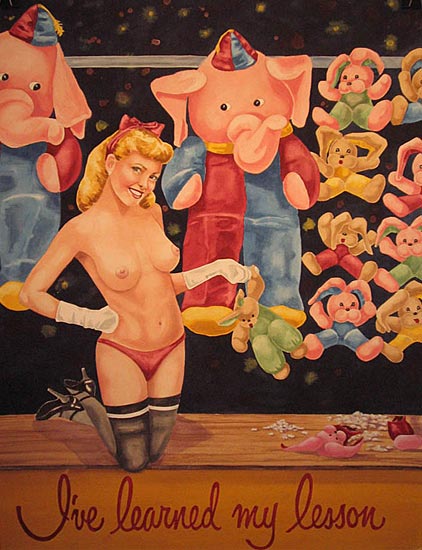
ARTIST'S STATEMENT:
Placed in the context of landscapes informed by the Hudson River School painters the idealized female is portrayed at the juncture of myth and social realism. The paintings refer to archetypes of fairy tales and mythology through a language of culturally specific symbols to explore both the female identity and broader cultural shifts. The grand American landscape is used not as a record of a specific place, but as iconic backdrop to an exploration of the fears and uncertainties that nip at the edges of the post-feminist landscape.
The paintings continue a centuries old tradition of depicting the female form in idyllic settings yet through incorporating symbols of America's idealized past the work probes a loss of cultural optimism and the ongoing irresolution of such post-feminist issues as sexuality versus intellectualism, passivity and acquiescence versus ambition. With references to mid-twentieth century imagery and advertising text the work courts irony and the inner narratives are playful, yet confront the conflicting expectations of contemporary culture and the intricately complex ways in which we form our identities.
While much of the narrative is intensely personal the underlying themes remain universal. The finished paintings are a pastiche of references and emotionally charged symbols that ultimately the viewer will respond to through their own personal history and emotional landscape. The paintings in this series are done in acrylic on canvas.
Working in water based media the artist is focused on depicting the idealized female in psychological-narrative scenes.
IRENE HARDWICKE OLIVIERI http://www.hammergallery.com/Artists/Olivieri/Hardwicke_olivieri.htm
"Neotoma cinerea"

Artist's Information:
Her work is heralded by critics nationwide. From the New York Times to the L.A. Times, from The New Yorker to Juxtapoz, art reviews reflect upon her work in like-minded fashion. Robert Costa, Cover magazine, best describes her style. Irene Hardwicke’s laboriously detailed paintings are intricate, obsessive and idiosyncratic – qualities associated more with personality than with any stylistic category. Though not “outsider” art per se, her work shares with that school a tendency to be all-inclusive, to leave nothing out. Her surfaces are often dense with tightly scrawled text and fantastic imagery relating to a favorite subject.
Ms. Hardwicke Olivieri’s paintings resound with depictions concerning relationships between the natural world and our own lives, especially hers. Each work is chock-a-block full of both visual and textual references to the cycles of nature, the symbiotic relationships in the plant/animal world, and the parallel worlds which exist between them and humanity. In all of her works we feel a constant and ingrained referencing of the ideologies of Emerson, Thoreau, and Muir. Additionally, we experience the similar self celebration advanced by artists as far-ranging as Walt Whitman and Frida Kahlo. And like Kahlo, as well as other exceptional women artists, Hardwicke Olivieri finds her way outside the dominant, masculine mode and turns, instead, her attention inward, creating a personal autobiography of astonishingly intimate self-portraits. The cultural and natural artifacts surrounding her figures are employed like a kind of clothing which not only surround but envelope her, and she becomes One with them.
The tradition of desire unconventionally employed is the theme best describing this artist’s vision. And it effectively offers us a window of experience wherein we are enabled to see and regain a sort of self understanding. By sharing this with the artist, we are free to re-examine and to participate with our own very secret life experiences and desires by translating them into new vistas of discovery, delight, and potential transformation.
REVIEW EXCERPT:
Eden, Again
Painted on old cupboard doors, weathered bits of driftwood, the lids of disassembled boxes and shutters that have come off their hinges, Irene Hardwicke Olivieri’s pictures of voluptuous women and virile men – set in fabulous landscapes teeming with all manner of flora and fauna – re-write the story of the Garden of Eden. Traditionally, the lesson to be learned from the age-old parable is that desire for knowledge inevitably leads women (with men following right on their heels) out of idyllic, uninterrupted contentment and into suffering, hardship and death – in other words, life as we know it. in olivieri’s hard-working hands, however, the pursuit of knowledge is not at odds with the pleasures of the flesh. Rather than linking curiosity and punishment – and thus establishing the foundation for an absolute division between heavenly ideals (or Godly perfection) and earthly inadequacies (or human frailties) – her meticulously crafted yet simply composed images invite viewers to entertain the idea that a healthy appetite for physical experience goes hand-in-hand with the desire to discover (and understand) humanity’s place in the cosmos.
excerpted from Irene Hardwicke Olivieri, Paintings, 2000, by David Pagel
ORLY COGAN
"Dreaming (Pillow Case)"
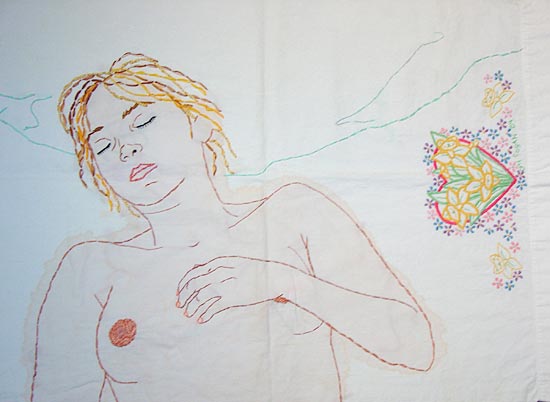
"Allegory"

Review of Orly Cogan's Tangled Up in You show
An embroidered nipple. Hand sewn pubic hair. Even the words provoke unease and curiosity, the desire to stroke the obscene with a tender hand.
Orly Cogan's manufactured and appropriated linens serve as the cultural backdrop for her ethereal figures, composed of hand sewn dotted lines and embroidered nether-regions. Often appearing like flighty '80s Oui Oui models turned gods and goddesses, each character is caught in the midst of nervous experimentation and ecstasy. Many seem unsure of their new-found innocence, while some take advantage of a another's distraction, sneakily petting a vagina, or holding a penis as though they were nicking a wallet.
Still others (the veterans of this world?) have ventured into bestiality. Many creatures, dogs, lobsters, and bears, seem to have intentions of their own, sometimes attacking vaginas, sometimes appearing as delighted cherubs around a couple's embrace.
Cogan's use of vintage fabrics, outdated but not beyond our recent memories, incites strange memories. Like a mother's apron and linens, or a green and brown, leaf-patterned tablecloth that we sat at refusing to eat our peas, we are already both attracted and repelled. By layering these scenes of sexual delight and unnoticed horror, Cogan seems to propose that these elements are ever-present, then and now, hidden by veils as thin as these.
Cogan eroticizes the very nature of linens and the act of sewing. Rather than simply reusing a previous generation's products for mere commentary, she nearly respects them, using them like two-way mirrors into the like-minded fantasies of competing generations.
In "Allegory," a mix of embroidery and paint on a pale, vintage tablecloth, a group of women are gathered like saints and angels in an ochre-flowered celestial-like realm where the night sky is dotted with deeply-pink areolas and thick embroidered hair. The women simultaneously embrace, fondle, and ignore each other to their own liking. The age and scale of each woman varies, creating a seemingly randomized hierarchy that hints at a state of constant flux between each woman's assertive and passive roles.
Cogan seems to make a statement about the role of women in general, as being something recently unhinged and possibly capable of exploding into a world of unfettered delight. The men, somewhat unchallenged in these works, seem to be just fine with that.
—Michael Kiser [mkiser@sedaqa.org]
--------------------------------------------------------------------------------
Orly Cogan: Tangled Up in You
Carl Hammer Gallery, Chicago
June 02—July 08, 2006
www.orlycogan.com
www.hammergallery.com
MARGARET HAWKINS REVIEW OF ANOTHER ORLY COGAN SHOW
Orly Cogan
BACHELOR GIRL - ORLY COGAN at Julia Friedman Gallery - Nudes on vintage fabrics provide witty contrast. - To paraphrase an old song, Orly Cogan enjoys being a girl, and her embroidered nudes offer a flip, hip irreverent take on the conventions of femininity. She achieves her signature look by stitching figures on dainty vintage fabrics. These found linens, which once served as table runners, bureau scarves and tablecloths in a more modest age, were already embroidered once by an earlier and more circumscribed generation of women. Cogan adds to these quaint decorations a layer of attitude that updates old-fashioned womanly crafts with a kind of happy-go-lucky postmodern perversity.
Thus we see prim rows of flowers and leaves forming a bower for the bachelor girl’in a series of soft-porn stitcheries that appears to be a kind of self-portrait of the artist with snack food. She is shown not just eating but smashing soft pastries into her mouth or against her body while staring provocatively at us and wearing nothing but panties and striped ankle socks.
The portrait Cogan offers of life as a ‘bachelor girl’ looks like loads of fun. There's nothing in here about paying the rent or even getting dressed. The world she shows us is one of pleasure and self-absorption with occasional drop in visits from like-minded nude males. When she's not eating or playing suggestive games with hand puppets, Cogan's bachelor girl lounges around talking on her cell phone and hugging her cat. And she stays voluptuous and pretty, no matter how many Hostess cupcakes and Pop Tarts she eats. What a life. The character Cogan creates is sort of a 21st-century female Hugh Hefner in much scantier pajamas. The trick here is that she's Playboy centerfold and playgirl all at once. She gets to keep her cake and eat it too. All this would just be propaganda for a point of view no one seriously disagrees with anymore except that Cogan's rendering is so appealing and so deftly integrated with the vintage fabrics she uses that the effect ends up being more than just the sum of its parts. The works are both decorative and witty. The embroideries are fairly primitive, made of neat basting stitches that clearly draw her subjects but without any of the subtlety of the originals that earlier generations of women sweated over with cramped fingers.
All the work is hand stitched embroidery on vintage linens,2004/2003.
WOODRUFF
"HYACINTH ARSONIST"
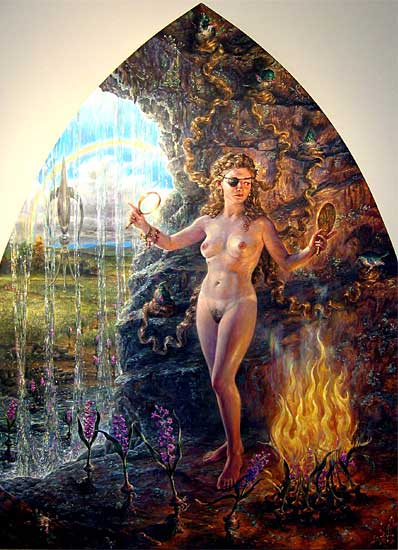
R. REGIER
"ROBOT"
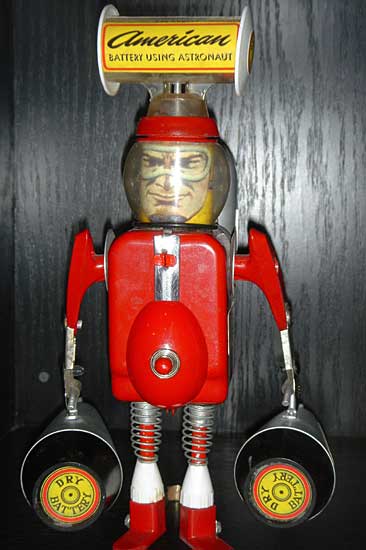
SPENCER DORMITZER
"If She Were Clumsy"
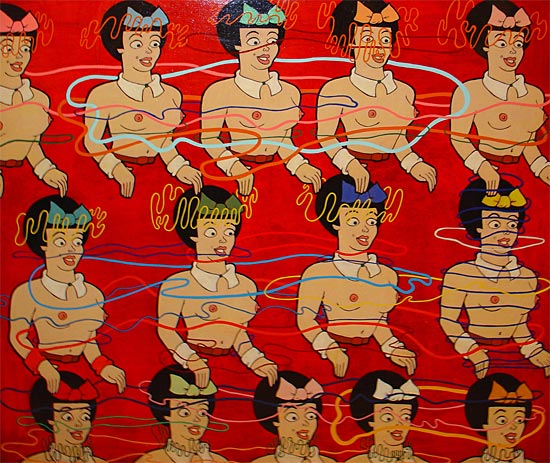
ELINOR CARUCCI
"Nataly and I"
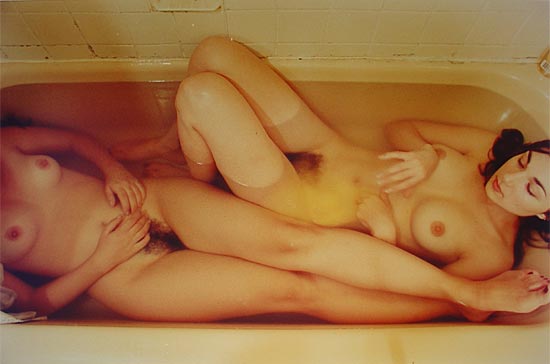
NICKY HOBERMAN
http://http://www.hammergallery.com/Artists/Hoberman/hoberman.htm
"Follow the Leader, Leader"
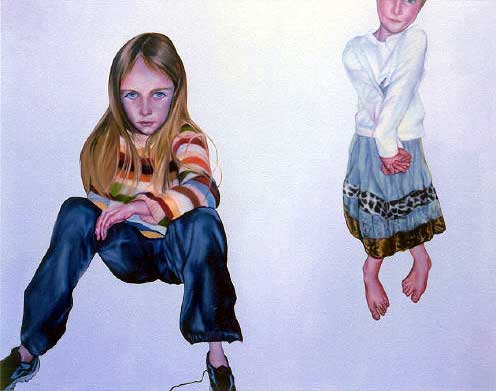
ADAM CONNELLY
"07.JPG"
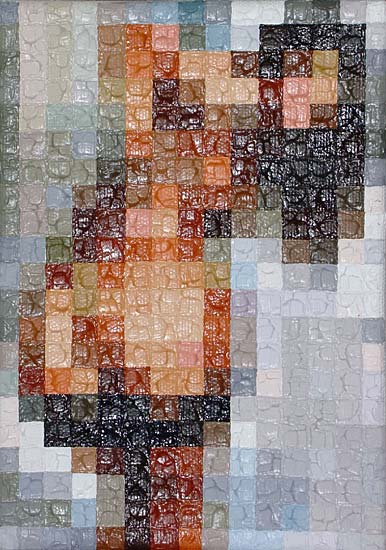
"011.JPG"
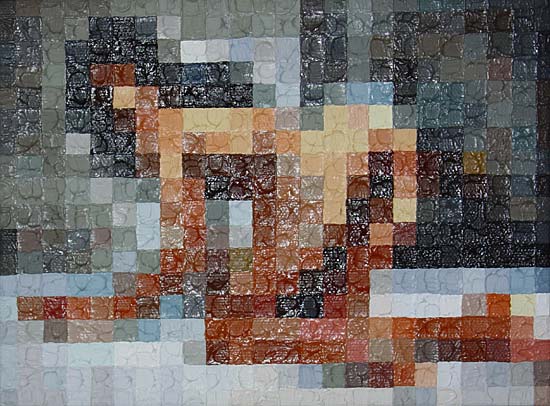
JOSEPH SEIGENTHALER
http://www.hammergallery.com/Artists/Seigenthaler/seigenthaler.htm
"Flydog"
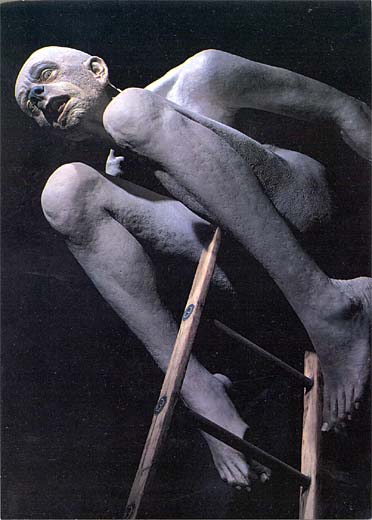
STATEMENT:
The simultaneously repulsive/beguiling mixed media figures of Joseph Seigenthaler didn’t just crawl out of some dark, murky, mysterious slime. They arrived by car, the CTA, they walked in city streets, they ate lunch in a neighborhood diner, their legs mended in local hospitals, they were entertained in the local movie theater. They were the man or woman who live just down the block. But it is, perhaps, the artist himself who is most studied in these fierce and unlikely recreations straight out of an Ivan Albright painting. Their fixed stares at first confront then transport the passing viewer, often into surrealistic realms of discovery and understanding. A transplant from the South, Seigenthaler has taken the resemblance of a latter-day Chicago imagist. His people studies are the quintessence of freak or sideshow subject matter. His transformational use of exaggeration and distortion creates a reality out of illusion and disillusion. "ALIVE!" they seem to shout while conveying to us a chilling association with all things improbably pre-historic or extra-terrestrial.
What we fear and draw back from is often the source of our greatest fascination. The remarkable and transformational sculpture by Joe Seigenthaler touches us in ways which both surprise and delight. We love the ability to suspend our own disbelief, and we uncover a more base and unfamiliar self in the process.
Born in Nashville, Tennessee in 1959, Joseph Seigenthaler currently resides in Chicago, Illinois, where he has exhibited his figurative sculpture for the past decade.
He received the Bachelor of Fine Arts degree in 1981 from the Memphis College of Art's painting department and afterwards began fabricating on a freelance basis life-size, realistic wax figures for various wax museums, primarily in Nashville and Sydney, Australia. The technical processes gained from this three-year period were to become influential in the development of his later explorations with the figures in clay.
From 1984 to 1986 Seigenthaler attended the Appalachian Center for Arts and Crafts in Smithville, Tennessee, where he became exposed to the possibilities of the ceramic medium. In 1987 he was awarded a three year tuition scholarship from Northern Illinois University in DeKalb, Illinois, where in 1990 he received the Master of Fine Arts degree.
Seigenthaler has taught ceramics and sculpture at the University of Montana, Missoula and Harold Washington College in Chicago. More recently he has taught part-time at the School of the Art Institute of Chicago.
The Virginia A. Groot Foundation awarded him their visual arts grant in sculpture in 1996, as well as a third place award in 1995. He was the recipient of a Regional Fellowship Award in sculpture from the National Endowment for the Arts in 1991 and a visual arts grant in sculpture from the Illinois Arts Council in 1990.
Recent exhibitions from 1997-1998 include "The Nude in Clay" at Perimeter Gallery in Chicago; "Out of the Shadow of Ivan Albright, Twelve Contemporary Chicago Artists" at the State of Illinois Art Gallery/ Chicago; the Sculpture, Objects, Functional Art Exposition in New York and Chicago; and one-person shows at Ann Nathan Gallery in Chicago. Seigenthaler was included in the 1994 exhibit "UnReal- Three Chicago Artists," curated by the SUNY Roland Gibson Gallery, State University of New York, Potsdam. He is currently scheduled for a solo exhibition in the Spring of 2000 at the Carl Hammer Gallery in Chicago.
His work is included in the permanent collections of the Museum of Contemporary Art, Chicago, and the Contemporary Museum in Honolulu Hawaii, as well as numerous private collections nationwide.
ELIZABETH SHREVE
http://www.hammergallery.com/Artists/shreve/shreve.htm
"The Secret Motion of Things II"
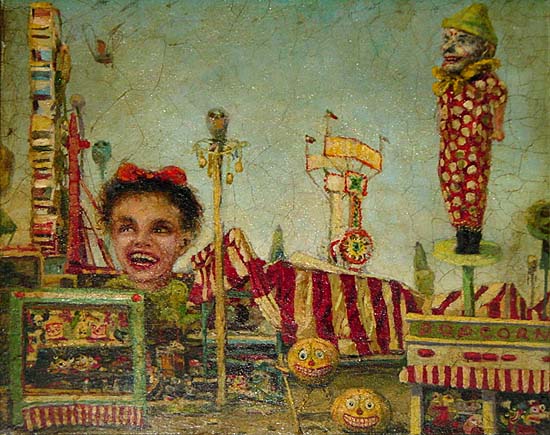
STATEMENT:
Painting is about experience meditated on in a peculiar manner with the hope of sustaining genuine feeling and selfhood despite the myriad of emotional dangers inherent in living. It is both more cruel and more intimate than everyday life in its effort to preserve the depth and complexity of intimate engagement with life, not just to reflect the accommodations necessitated by our emotional and physical survival. At its best it is a compassionate endeavor; a form of experiencing that feels fully; accepting pain, grief and joy without the indulgences of judgement that limit our vulnerability, need, and fear but also our sense or realness. Thus, my paintings express a world that possesses me as much as I feel I possess myself. It is a troubled love within the dream of my painting, but one in which I believe the vulnerable can survive.
Elizabeth Shreve
PHYLLIS BRAMSON
http://http://www.hammergallery.com/Artists/Bramson/Bramson.htm
"Avarice"
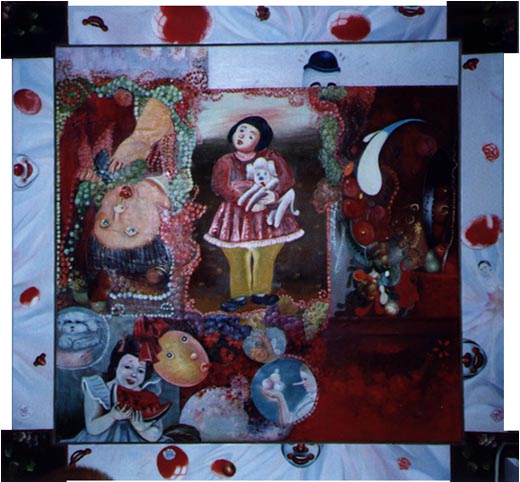
ARTIST'S STATEMENT:
At one point or another I infuse my work with parody strategies, arbitrariness and
ephemeral counteractions about love and affectionate feelings in a hostile world.
Often burlesque-like and erotically hypersensitive, the images meander between a
physical and mental existence that juxtaposes the nonsensical with the profoundly
meaningful. The work becomes a site for sexual discourse often pushed into a
precarious state, a state where one can get lost in a tangle of fear, desire and
intoxication.
The motifs I use are based on the co-presence of memory and fiction, suggesting a
miniaturized fairytale-like illusionary life that offers up all sorts of cosmic possibilities.
Beginning invisibly and unconsciously, when the narrative and forms finally develop
they become distilled, killed, seductive, lost, self-containing and overflowing.
Thus the activity of making becomes a meditation about pleasure, trauma and the
difficulty of being, all the while distilling the senses and addressing quirks of the soul which I want to articulate beautifully and idiosyncratically. Finally my paintings are ruminations about submerged eroticism played out against operatic opulence, refined and dressed to reflect the terrible melancholy of nostalgia and loss.
DON BAUM
http://http://www.hammergallery.com/Artists/Baum/baum_don.htm
"Heart's Desire"
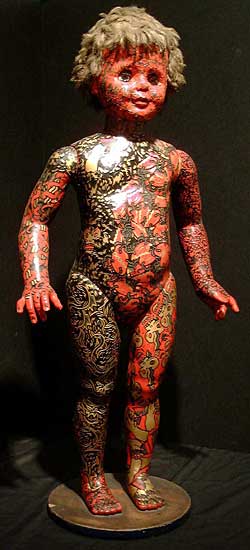
http://http://www.hammergallery.com/Artists/Ottens/ottens.htm
"Hugger Mugger"
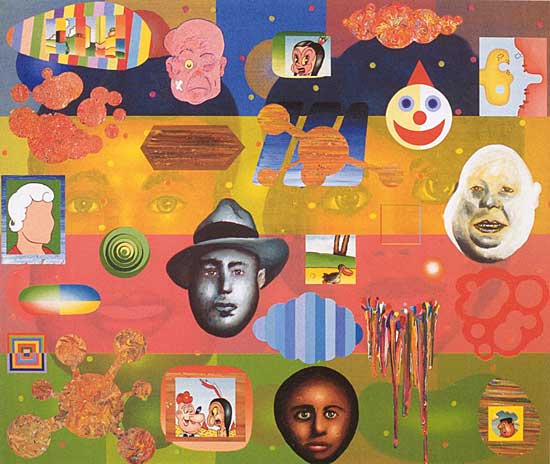
Mary Lou Zelanzny
http://http://www.hammergallery.com/Artists/Zelanzny/zelazny.htm
"Ignis Fatuus"
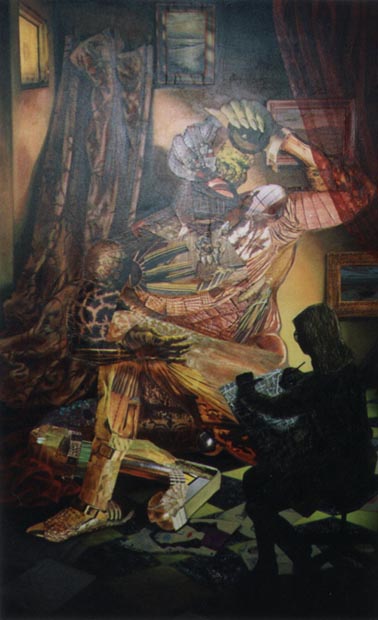
"Hidden Trojans"
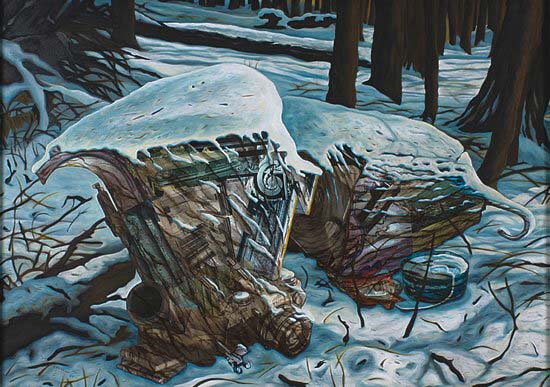
STATEMENT:
The Carl Hammer Gallery is pleased to welcome Mary Lou Zelazny in her first one-person exhibition appearance here. For over 18 years we have observed the career of this artist develop as she has masterfully worked to inject collaged pop culture imagery into her paintings. For us, the public, great satisfaction is derived when the perfect, unexpected element, or lost piece of the puzzle is found and made to be a part of the greater whole. Her combining the gestural fluidity of paint with the slickness of the clipped photograph creates a hybrid form which is both expressive and stimulating.
In much of her work, Zelazny explores and pays homage to elements of pre-modern art history. Among the many genres that she has worked into her paintings, landscapes, still life, and portrait paintings seem to dominate. The human figure, especially the female form, parades most often through her work. Those initial inspirations, combined with collage, seem to create the new worlds allowing her own observations to inhabit. And all the while that the process seems to work as an introduction to the viewer, to rethink the clichés of romance, surrealism, and pictorialism, Zelazny surreptitiously introduces herself through the clichés.
This most recent work by the artist uses the effects and gestures of a loaded brush to create new collage material. Mono-prints, splashes, drips and pours have replaced the found, photo-based images. These new elements seem then reorganized and combined with more traditional techniques so that a variety of textures and patterns coexist within the larger narratives of the paintings themselves. From the tension and movement of all the ingredients, and in their flickering reassembly, we become infected from the realization of her passion and excitement.
David Sharpe
"8-15-77"
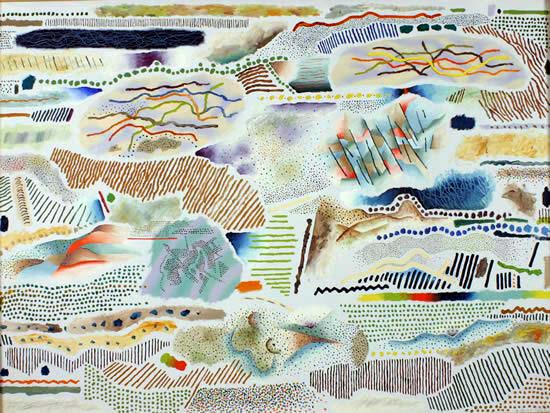
STATEMENT:
It is with great pleasure that the Carl Hammer gallery presents its first solo exhibition of new paintings by internationally acclaimed artist David Sharpe. Mr. Sharpe is no stranger to Chicago. A graduate school standout at the School of the Art Institute, Chicago, his artwork has been a familiar part of the Chicago exhibition landscape since 1968. He was, up until recently, a mainstay in the stable of artists from the venerable Sonia Zaks Gallery. We are privileged, now, to continue representing his work to the greater Chicago and vicinity area. In the latest of a long list of achievements, Mr. Sharpe was awarded The American Academy of Arts and Letters 2006 annual purchase award for The Universe, a recent painting by the artist.
A prolific painter, David Sharpe’s consistency is marked not only by its quality, but of his willingness to explore beyond the perceived limitations of his range. Recently, his production of work provides us a greater insight to the painting process with much more visible drawing present, an integrated exposure of the layering of the paintings themselves. The process is much more immediate, not as a stream-of-consciousness, but certainly very direct in terms of approach.
The Landscape, more prevalent in his paintings years ago, is reintroduced by Sharpe in this newest work. Though there is still an active involvement with figuration as well, this new engagement with issues, like natural phenomenon, is saying something personal and new about the artist as well. “We all know what a sunset looks like, but a work of art can redefine for us the way we look at nature or can help us to define any personal experience whether it be perceived or felt. I like it when I look at a sunset and say to myself – there is a Joseph Yoakum sunset or mountain, or perhaps it reminds me of a Van Gogh,” quotes the artist. Or perhaps it is, in part, a reaction to the immense amount of work which is so media based. “So much art today relies on magazines, computer, or TV. Things can get very sterile very quickly when all you respond to is the corporate world. It is much more challenging for me to take the commonplace as my subject than to appropriate the bizarre and serve it up as invention.”
The inventiveness and insightfulness of David Sharpe’s paintings truly bring us back to a contemplative re-inspection of that which surrounds us every day. More importantly, they also take us to the new places in our private worlds of self-discovery
Hollis Sigler
"You Were the Most ..."
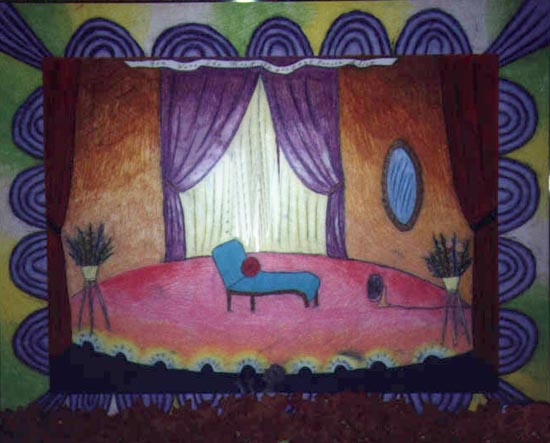
"The Phoenix Takes Flight"
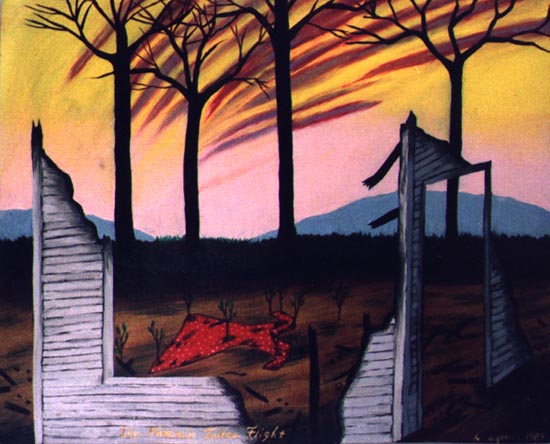
"She Knew SHe Could..."
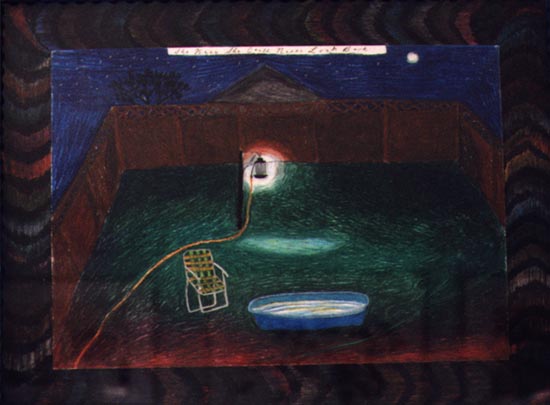
STATEMENT AND ARTIST INFDORMATION:
Hudson Hills Press to Publish Unique Journal
Of Beautiful and Moving Paintings
Documenting Artist's Struggle with Disease
Hollis Sigler's Breast Cancer Journal
"Sigler's entire career has been a testament to the communicative graces of art,
and in the Breast Cancer Journal she reminds us
that art can accomplish this in a way that nothing else can,
and that sometimes, preciously and rarely, it will do very much more.
Sometimes art can be a matter of life and death." - James Yood
Hollis Sigler, a leading feminist artist, was diagnosed in 1985 with breast cancer, a disease that had also stricken her mother and great-grandmother. After it recurred, she began a pictorial journal, now encompassing more than one hundred works. Art in America magazine called Sigler's Breast Cancer Journal "one of contemporary art's richest and most poignant treatments of sickness and health… Taking on a kind of religious conviction, her jewel-colored symbols imbue a death-haunted situation with miraculous, celebratory life." These works- and the commentaries that the artist inscribed on many of them- combine personal experience with family history, medical statistics, and political consciousness raising.
This inspiring volume brings together the sixty finest works from the Breast Cancer Journal in full-color reproductions- paintings, drawings, prints, watercolors, and cut-paper pieces- each accompanied by the artist's commentaries. Dr. Susan M. Love, a leading authority on breast cancer, discusses the importance of Sigler's art as a document on the disease's personal impact. "Hollis Sigler gives a voice to the woman struggling with the reality of breast cancer- not the ever-happy face the public wants to see, but the real face of a woman living with a chronic and potentially life-threatening disease. It is this reality that makes her art so difficult for many women to face, and it is this reality that also makes it so powerful."
James Yood recounts the aesthetic trajectory of Sigler's career, and of the Breast Cancer Journal in particular, drawing parallels with Frida Kahlo, another artist whose life and work were significantly affected by a medical condition. He is also "reminded of late works by Rembrandt or Pablo Picasso or Ivan Albright, when these artists looked squarely in the face of their death." He writes of Sigler: "In work after work she explores what it means to love, to enjoy small pleasures, to consider both the wonder and the ambiguities of human relationships, and to inventory the thousand tender wounds of intimacy… Sigler's images, with their titles often scrawled across them, constitute a corpus of work revealing the possibilities for a genre painting of the human spirit at the end of the twentieth century."
Sigler herself, in an essay titled "To Kiss the Spirits," writes of her life as a woman, as a lesbian, as an artist, as a person with breast cancer, and as a breast cancer activist, also relating the history of various art projects and exhibitions that culminated in her Breast Cancer Journal, a project undertaken with the hope that "the work would thus gain the power to destroy the silence surrounding the disease." She also discusses many metaphoric images that appear and reappear in the work, such as the vanity and its mirror, a dead and broken tree, her mother's dress, and the Winged Victory of Samothrace. The titles of the paintings alone provide a poignant glimpse into the mind and spirit of this remarkable artist:
The Illusion Was to Think She Had Any Control over Her Life
Trying to Maintain an Air of Normalcy
The Future Moves in Much Closer
What Does the Lady Do with Her Rage?
Following the Ghosts of Our Grandmothers into the Future
In Spite of All, She Rises in the Morning with Joy in Her Heart
Wishing She Could Take a Vacation from Her Disease
It Starts with One Errant Cell
A Wish to Touch the Sky
In the Unfolding of Life, Every Minute Is Precious
She Had No More Room for Sorrow
We Have Sold Our Souls to the Devil
Hollis Sigler’s Breast Cancer Journal is a beautiful art book and a unique testament to the human spirit, a fundamental affirmation of the possibilities of life discovered in the midst of agony and loss. To be published during National Breast Cancer Month, October 1999, it is the artist’s gift to all whose lives have been touched by this disease.
Dr. Susan M. Love is the bestselling author of Dr. Susan Love’s Breast Book (Addison Wesley, 1990/1995) and Dr. Susan Love’s Hormone Book (Random House, 1997). A breast cancer surgeon, researcher, scholar, teacher, and activist, she studies and taught at Harvard Medical School before moving to the U.C.L.A. School of Medicine. She is also Medical Director of the Santa Barbara Breast Cancer Institute and one of the founders of the National Breast Cancer Coalition. She has been appointed to the National Cancer Advisory Board.
James Yood, born in Elizabeth, N.J., studied at the Universities of Wisconsin (B.A.) and Chicago (M.A., Ph.D. candidate). He teaches at Northwestern University in Chicago and is the author of many books on Chicago art and artists.
Published by Hudson Hills Press
Tending the Garden
“In the face of terminal illness, those afflicted have been known to do extraordinary things. While compelled to cope with the physical effects of disease, many artists, writers, and performers have created works directly related to or informed by illness. Confronted with a new identity and status as ‘sick person,’ they have questioned the meaning of life, fate, and destiny or addressed social and political issues surrounding their illness. An energy and freedom seem to follow the diagnosis of a disease that will remain with a person for the rest of her life.
Hollis Sigler’s Breast Cancer Journal is a public acknowledgement of her longtime battle with breast cancer. First diagnosed in 1985, Sigler was told seven years later that the cancer had metastasized to her bones. Responding to the disease’s permanence, it seemed natural, unavoidable, to incorporate breast cancer into her art. Since the mid-1970’s, Sigler’s continuing pictorial diary of confessional paintings and drawings has revealed her desires and fantasies, as well as her fears and sorrows. Rendered with a vibrant palette and a childlike simplicity, her fictional spaces scattered with personal effects symbolize complex and intense emotional states. Though Sigler continues to employ her vigorous yet delicate style, the content of her works shifted dramatically when she found the cancer had spread. Accepting her social responsibility as an artist, she decided to incorporate the ‘cause’ into her work. “
- Stacy Boris
TULLMAN COLLECTION TULLMAN COLLECTION TULLMAN COLLECTION
